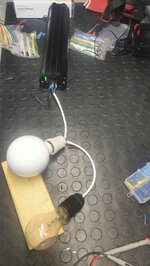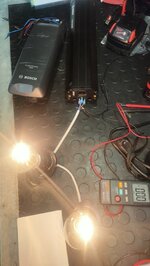Out of curiosity, what was the resistance of the 3 x 12v globes?Perfect, thanks for advise.
I have connected directly 220V 100W bulb to battery terminals and supplied +5vdc to "charger" terminal and BMS is not tripping anymore.
But I need to increase load as my 1 bulb 220V 100W takes ~0.18A only (measured by multimeter) and it will take forever to discharge the battery.
Resistance of bulb + wires ~36Ohms + battery resistance ~98Ohms gives 134Ohms
I=U/R; I=36v/134Ohm=0.26A which is close to multimeter readings.
Thanks again for yours advice.
FYI, on the German pedelec forums, people mentioned their Bosch battery charge cycle count was getting incremented rapidly by playing around with the 5VDC on the CAN line, how accurate this is, i have no idea.


